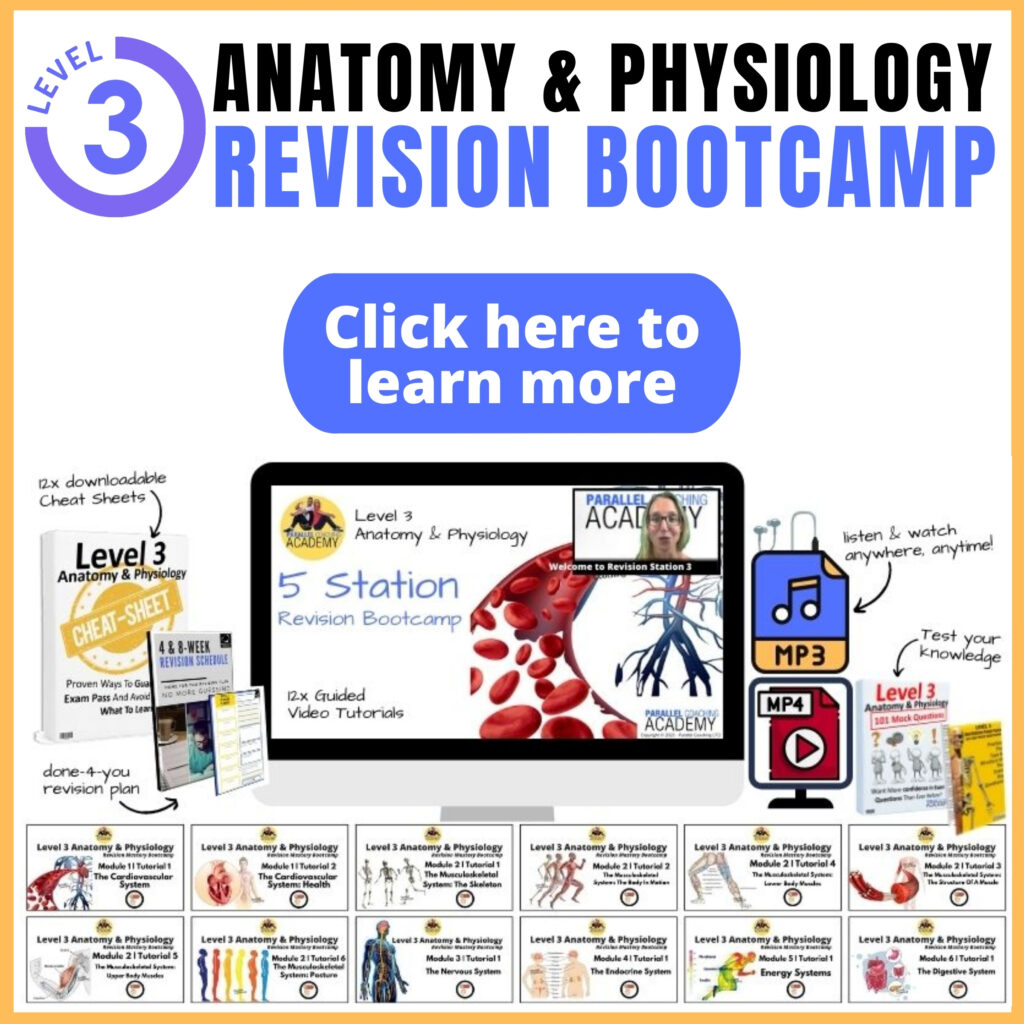This blog will teach you EVERYTHING you need to know about the Inner Core Unit for your Level 3 anatomy exam
You’ll discover:
- Why FitPros find the Inner Core Unit confusing hard to revise
- A 7 min Video Tutorial
- Which 4 muscles make up the Inner Core Unit
- What is Intra-abdominal pressure?
- How to explain the location of the core muscles
- How many questions you will have in your exam
- Three Mock Questions to test your knowledge
- How to learn with simplicity for all of your L3 Anatomy exam
Why FitPros find the Inner Core Unit confusing to revise
The Inner Core Unit is one section in the Posture and Stability module of the Level 3 anatomy and physiology exam.
Unlike other areas of the posture and stability module, the Inner Core unit is usually a topic that FitPros get wrong; and here’s why…
The term “core” is used a lot in the gym, it is used to make reference to stabilising muscles like the TVA and mobilising muscles like the rectus abdominus.
And this is confusing because it doesn’t differentiate the INNER CORE UNIT from the superficial muscles of the mid-section.
This same terminology can cause some issues on exam day, if you don’t learn the exact muscles that make up the inner core unit and their location.
7-minute Video Tutorial:
Leap inside this 7 mins video, it’s taken directly from the old version of our Level 3 Anatomy Revision Mastery Bootcamp so you can feel confident on exam day.
Which 4 muscles make up the Inner Core Unit?
The inner core unit is comprised of four key muscles, which you need to know about for your level 3 anatomy and physiology exam.
These muscles include:
- The Diaphragm
- The Pelvic Floor
- The Multifidus
- The Tranversus Abdominus (TVA)
These 4 muscles work together to create stability and to protect our spine, ligaments and intervertebral discs.
What is Intra-abdominal pressure?
When the muscles contract they tighten the cylinder which creates a firm column throughout the torso and relieving pressure from the spine itself.
This is called Intra Abdominal Pressure, and pressure is increased by activating the core. An activated core is the same firm “tensed” feeling that you get when you cough or sneeze; the TVA tightens and pulls in, the pelvic floor tightens and the diaphragm contracts to create this hard protective cylinder.
How to explain the location of all 4 muscles
Make sure you are aware of the following wording, in preparation for your anatomy quiz questions
- Superior = Upper most = Diaphragm
- Inferior = Lowest = Pelvic Floor
- Posterior = Furthest Back = Multifidus
- Anterior = Furthest Forward = TVA
How many questions you will have in your exam
The Level 3 Anatomy and Physiology Exam will usually have 40 multiple choice questions, but this varies so make sure you check with your provider.
With 40 questions total, you can expect there to be 3-5 questions on Posture and Core Stability, including the inner core unit.
But it’s not just about having the knowledge to pass the exam it’s about using this knowledge when training clients.
In summary
- EVERYTHING about the inner core unit
- How many questions you will have in your exam relating to this topic
- That you can learn simply and easily with our video tutorials
Test your knowledge with today’s mock questions:
[NOTE: The answers are below the 3rd questions]
Q1: Which of the following forms the inferior aspect of the inner core unit?
A. Erector Spinae
B. Diaphragm
C. External Obliques
D. Pelvic Floor
Q2. Which of the following is NOT part of the Inner Core Unit?
A. Tranversus Abdominus
B. Rectus Abdominus
C. Pelvic Floor
D. Diaphragm
Q3. Which exercise would be most effective for training Intra Abdominal Pressure?
A. Plank
B. Full Sit-Ups
C. Back Extensions
D. Bicycle Kicks
Anatomy Quiz Answers
1 = D
2 = B
3 = A
If you want more mock questions like this, then you can download more Free Mock Questions: DOWNLOAD NOW
Need More Help with your Level 3 Anatomy Revision?
For Trainee FITPROS Taking Their L3 Anatomy & Physiology Exam.
Learn, Revise & Pass Your Level 3 Anatomy & Physiology Exam In Under 10-hours
(Without Having To Spend Hours Revising Or Feeling Overwhelmed)
If you want to get your revision structured, learn everything you need to know and feel confident on exam day, then click the link below:

Dedicated to More
Hayley “Inner Core Unit” Bergman
Parallel Coaching
P.S. You can also find us on the following platforms:
Instagram: Follow Now
Facebook: Like Our Page
Twitter: Tweet Us
YouTube: Subscribe Here
More Anatomy Revision Blogs: HERE

